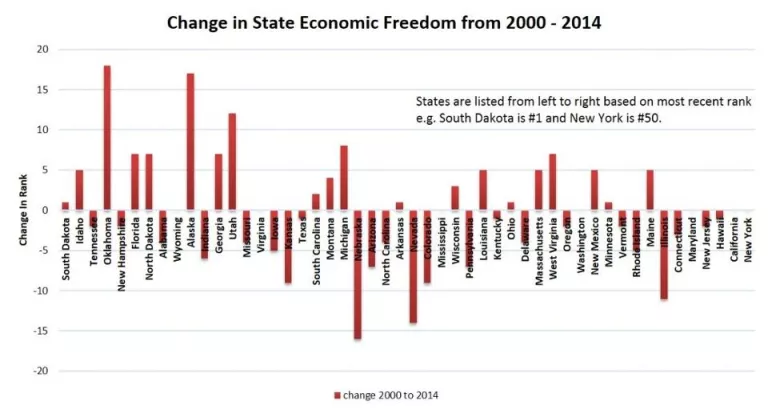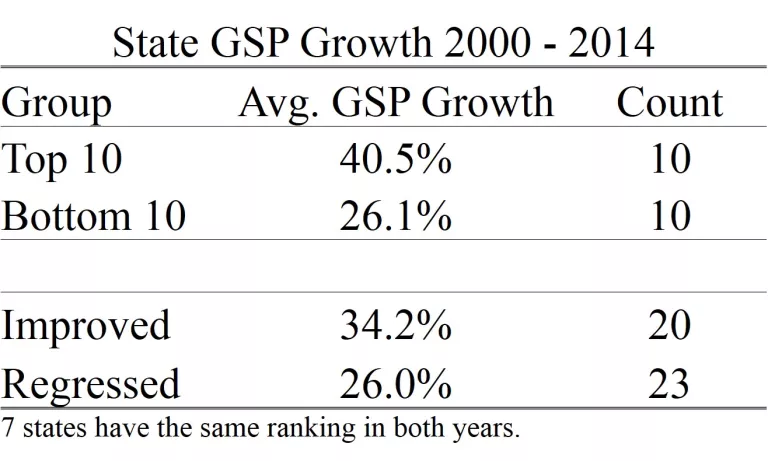- | Housing Housing
- | Expert Commentary Expert Commentary
- |
If We Want More Economic Growth We Need More Economic Freedom
A committed effort to improving economic freedom by voters, government officials and policy makers at all levels of government can help get the U.S. economy back on track.
The 2016 Economic Freedom of the World report published by the Fraser Institute was released recently, with the United States ranked 16th. This is merely the latest poor ranking in a steady downward trend since 2000. There is a positive relationship between economic freedom and economic growth so it’s unsurprising that America’s decline in economic freedom has coincided with decline in its GDP growth: Since 2000 GDP has grown by 1.78% per year on average, compared to 3.67% from 1983 – 2000 when America’s economic freedom score was increasing.
When people are free to produce and create, unfettered by excessive government interference, they create new products and services that improve our lives. If we want our standard of living to keep increasing, we not only need more economic freedom at the national level, but at the state level as well.
The 2016 version of Freedom in the 50 States, published by the Cato Institute, ranks the 50 states by three different measures of freedom: fiscal, personal and regulatory. In this year’s rankings New Hampshire was number one overall, followed by Oklahoma and Indiana.
As part of the ranking the authors have created state-level economic freedom scores using 2000 and 2014 data, along with several years in between, and we can use this data to track improvements or declines in each state’s economic freedom over time. In the figure below the states are listed from left (#1) to right (#50) based on their 2014 economic freedom rank. The vertical bars indicate how much each state’s ranking improved (positive number) or declined (negative number) from 2000 to 2014. 
However, there were several larger changes in the middle of the ranking. Oklahoma is ranked fourth in the most recent ranking, an improvement of 18 spots since 2000. Idaho, Florida and North Dakota are also in the top ten at two, six and seven respectively, and all of them improved by at least five spots since 2000.
On the other end, Pennsylvania and Illinois, through never very free according to this data, fell from 23rd to 30th and 33rd to 44th respectively. Nebraska suffered the largest drop, falling from 6th in 2000 to 22nd in 2014, a decline of 16 spots. Kansas, Nevada and Colorado also experienced relatively large declines.
But what does a change in economic freedom mean for a state’s economy? The table below shows the average growth in real Gross State Product (GSP)—the state-level equivalent of GDP—from 2000 to 2014 for the ten states that improved their ranking the most and the ten states that regressed the most, as well as for all of the states that improved and all of the states that regressed. GSP data are from the Bureau of Economic Analysis website. 
As shown, the states that improved their ranking from 2000 to 2014 had greater GSP growth on average than the states that regressed. The 10 states that improved the most grew by 40.5% on average from 2000 to 2014, while the 10 states that regressed the most only grew by 26.1%. Likewise, the economies of the 20 states that improved grew by 34.2% on average while the economies of the 23 states that regressed only grew by 26%.
While averages such as these are not proof that more economic freedom causes more economic growth, these results are consistent with what we know about economic freedom and economic growth at the national level, namely that economic freedom has a positive, direct effect on economic growth. There are good reasons to believe that a similar relationship exists at the state level.
The pernicious decline in economic freedom at the national level doesn’t bode well for America’s economic future—as national economic freedom declines, growth is declining along with it. Similarly, economic growth has been lower in states where economic freedom has declined. A committed effort to improving economic freedom by voters, government officials and policy makers at all levels of government can help get the U.S. economy back on track.